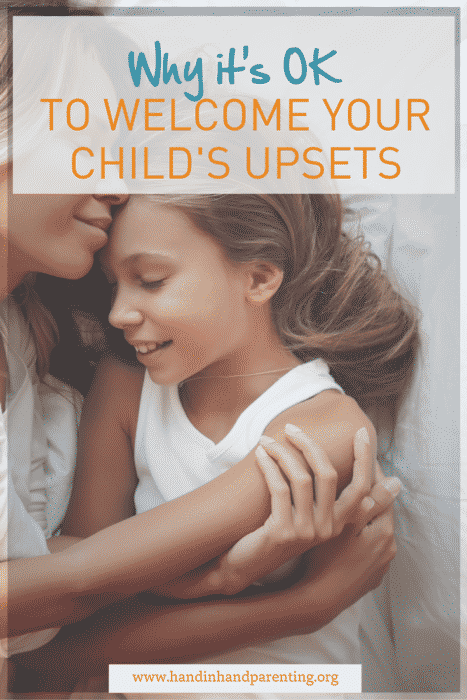![]()
A Guest Post with Roma Norriss
 Tantrums are an inevitable element of childhood. No matter what we do, beginning at around age two, big upsets and crying always appear. It can be as late as six before we see them stop, although many parents see big cries from much older children too – something that seems less talked about.
Tantrums are an inevitable element of childhood. No matter what we do, beginning at around age two, big upsets and crying always appear. It can be as late as six before we see them stop, although many parents see big cries from much older children too – something that seems less talked about.
Most parenting approaches are geared towards stopping the cries, but at Hand in Hand Parenting, cries are welcomed and they are seen as supportive of a child's development.
Here, Roma Norriss, a Certified Hand in Hand Instructor, explains how tantrums are not only a natural part of child-raising, but why they should be seen as both good and healthy.
Q: Hand in Hand comes from the view that all feelings are ok, including tantrums. Can you help explain why?
We welcome tantrums because we believe that when children tantrum they eliminate their emotional poops.
Q: What exactly is an “emotional poop?”
When children are stuck emotionally somewhere, and they need to release some heavy feelings. Those feelings are the ones that stop them being the sweet, loveable children that we know they are. They are working to eliminate the emotions they don’t need, and to make space for more fun.
Q: Parents often feel the need to stop a child's crying. How does the Hand in Hand approach differ?
We use a tool called Staylistening. That's where you stay close by to your child and you listen for the duration of their upset.
Q: Isn't that difficult?
Yes, I think this is a tough one for parents because it is hard to listen to a child crying. We have the impulse to make it stop because we think that’s the cause of their upset, but actually crying is more like the side effect. It’s their natural way to release feelings.
It’s hard for us because we were told to stop crying. Often what we heard when we cried was our parents telling us things like, “People will look at us and think we are crazy,” or “You are ugly when you cry.”
Q: How do you Staylisten?
All you are aiming for is just paying your attention to your child and listening to their feelings, really. We say very little when we Staylisten. We can say, “I'm right here,” or “I know it's hard.” We repeat just a word or two to see if the pretext for crying is still alive.
Q: So, if they were crying about the red cup you gave when they wanted blue, you might say something like, “I know. You wanted the red cup,” very softly, and see how they respond? Because that's where they are dumping their feelings?
Yes. They will find a good reason to cry. If we Staylisten to the end of the cry we actually have the opportunity to help a children's feelings about other things, other than that just the pretext they started crying about.
 Q: The Staylistening process might take some time, especially the first few times when children might have lots of backed up feelings. What about the times we just don't have time?
Q: The Staylistening process might take some time, especially the first few times when children might have lots of backed up feelings. What about the times we just don't have time?
Right. I'm a single mum which means that I'm often juggling nine things at once and I'm working and I don't always have time to listen as much as my children need or, at least, straight away when they need it!
Sometimes I can see that they waiting for the feelings to be listened to. My daughter will become less co-operative, she'll get kind of grumpy about everything, she'll be a bit rough with her body and everything becomes a problem. If I don't have time to move in close, then I let it go for a couple of days. You know, I'll give into the thing that she was being rigid about, or I'll let her have the ice-cream she is begging for, or whatever, but I know that an upset is brewing.
Learn more about Staylistening The Science Behind the Staylistening Tool
Q: How does this play out. Can you share an example of when it happened?
Yes. We got to school one day and she was really rigid. I actually didn't have to go to work that morning so I just thought that we'd be late for school that day. I can't remember what I initially set the limit around, but at some point, I said, “We won't go to school right now, but I need you to get into your car seat so we can go park around the corner. We're not parked in a good place here.”
She's usually fine with her car seat so it wasn't an issue with the car seat.
Q: That became her pretext for crying?
Right. She was saying, “No, I won't! I won't get in!” and I was saying “I need you to sit in your car seat, I need you to buckle up.”
She kept on: “No I can't get in,” and I was saying “I do need you to sit down, I do need you to put your belt on.”
She was coming through into a big rage, and I just listened. I just stayed put and I said: “I see you're really upset, I'm right here with you.”
She started moving around the car and getting very hot and sweaty. She went and sat down in the deep between the seats, and she found a soft toy, a cat. She started playing with the cat, and I could see that she was distracting herself, so I kept the limit. Still softly I said, “No, no. We're not going to play with the cat now. We're just going to get into the car seat.”
She started climbing up and shouting, “I need to get out! I can’t breathe!” It all got quite urgent.
I was saying, “I’m with you, it’s ok, I can see you breathing.”
And then eventually, when the storm passed, she quite happily, just quietly sat down and put herself in the car seat, and for the rest of the week she was back to her usual sweet co-operative playful self.
This post was inspired by Roma's recent Facebook Live with Irina Nichifiriuc
You can watch the full recording here. It includes a roleplay for the Staylistening tool.
Learn more about Hand in Hand's revolutionary approach to parenting in our Monthly Newsletter and in the book Listen: Five Simple Tools to Meet Your Everyday Parenting Challenges
Meet the Instructor
 Roma Norriss is a Hand in Hand Parenting Instructor based in the UK.
Roma Norriss is a Hand in Hand Parenting Instructor based in the UK.
